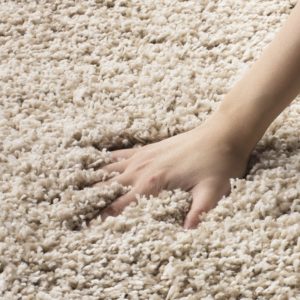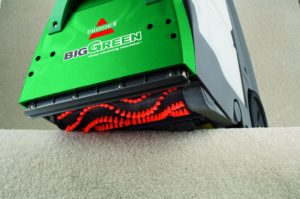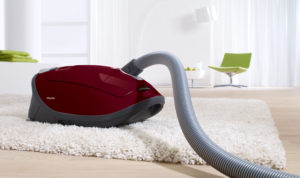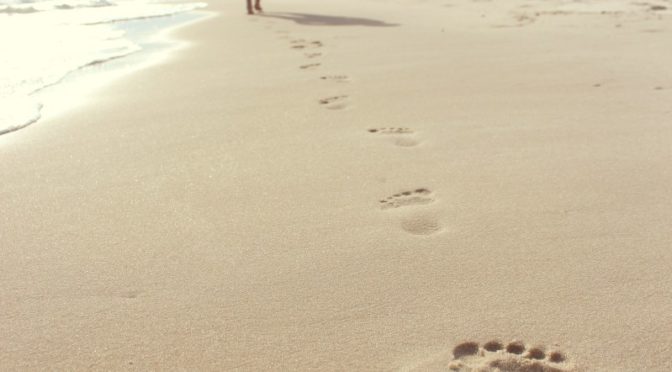
One of the most frequent requests we come across from homeowners interested in new carpets is for carpets that won’t show footprints or vacuuming marks for all the world to see.
While this doesn’t bother everyone, there are many people with carpets that do leave variances in shading, and some will even go as far as avoiding walking across their own carpets, creeping along edges, hopping from one section to the other as if the carpet were made of lava, or even vacuuming behind themselves to avoid leaving traces. While some of these examples may seem extreme (perhaps even obsessive or compulsive), the underlying fear of discoloration due to normal use is something many of us understand. Today we’ll look at why some carpets show and others hide footprints and, more importantly, which ones to choose and which to avoid if those prints bother you.
What makes a carpet show tracking marks (footprints, vacuum marks, etc)?
Before examining which carpets won’t show tracking marks, it’s worth understanding what makes other carpets reveal them to (seemingly) everyone. When most people think of a revealing carpet, they’re thinking of straight saxony carpets. Straight saxonies have an appearance that somewhat resembles velvet, and it comes from carpet fibers that are generally twisted to face the same way. As a result, brushing a hand, foot, shoe, or vacuum across the carpet will move the fibers you touch, causing them to reflect light waves (hello high school physics!) at different angles, and as a result, appear darker (although sometimes lighter) than undisturbed neighboring fibers.
Thanks for the science lesson! Now how do we hide those carpet marks?
Now that you know what leads to tracking marks in certain carpets, to avoid such marks, you want carpets with varied textures so light’s already going every which way already. In other words, you want a bad hair day over a good one, because that way, there’s nothing left to ruin. In short, you’re looking for textured saxony carpets, looped Berbers, friezes, and higher piles in general. You’ll want to stay away from cut and loops and the aforementioned smooth saxonies. Let’s look at these styles in detail.
Think of textured saxonies

Textured saxonies are an alternative to straight saxonies–in fact, when it comes to showing tracking marks, they’re polar opposites. Textured saxonies, like the straight variation, are cut-pile carpets with equal fiber heights. However, unlike straight saxonies, they’re designed from the ground up to hide tracking marks. Also known as trackless carpets, textured saxonies scatter light through twisted carpet fibers. Since the fibers face different directions, they disperse light waves. Practically speaking, this means the colors will stay more or less the same when you pass your hands, feet, shoes, or vacuums over them. Keep in mind, though, that textured saxonies won’t stop all tracking or shading. As a result, if you can’t stand any shading, you’re going to want a different carpet style.
Look for looped berbers

Looped carpet styles work very well for people who don’t want any visible variances in shading or tracking marks. The tight loops camouflage shading, as the fibers have minimal motion due to the loops. Beyond this factor, berbers will typically be made from fibers resembling wool (e.g., olefin), resulting in a less lustrous appearance. Duller fibers, by definition, reflect less light than brighter ones, which is another way of minimizing variances in shading.
Find a frieze or high-pile carpet

Frieze carpeting styles are yet another way of reducing visible tracking marks. The carpets are highly textured with loose and long fibers; the looseness in the pile and the high degree of fiber twist results in a great degree of light dispersion. Additionally, frieze carpets are another low luster design, resulting in less reflection. If you don’t want a frieze carpet, also consider a high-pile carpet; the higher the pile, the greater the density and complexity (randomness) of the fibers, which is another fancy way of saying they’re going to envelop tracking marks instead of reveal them.
…but keep away from cut and loops
While you might be tempted by cut and loop carpets due to a belief that the patterned fabrics will hide tracking marks, the truth is that they’re still going to show some shading. The cut portion of this carpet style involves uniform fibers a la saxony carpets, which negate the advantages of the loops, which provide variations in height and texture. They won’t show as much as straight saxonies, but they’ll show more than berbers and much more than friezes.
Lean toward lighter colors
Beyond the style of the carpet itself, consider the color carefully. Light colors hide shading variances more than mid-tone colors and far more than dark colors; this is because our eyes are sensitive to contrast, and dark colors inherently provide more contrast in lit rooms (whether by sunlight or artificial lighting) than lighter colors. You might also want to consider two-toned cut pile carpets; the mixture of lighter and darker fibers is another effective way to reduce shading variance visibility.
Do certain carpet cleaners or vacuums prevent shading variances?

Unfortunately, you’re not going to be able to buy a carpet cleaner or vacuum that’ll keep shading variances from appearing; this is a carpeting issue, not an appliance issue, and some carpets are simply going to do a better job than others.
That said, we still recommend the Bissell 86T3 Big Green for carpet cleaning tasks and the Miele Complete C3 Soft Carpet or the Miele Compact C2 Electro+ for vacuuming. We’ve had the opportunity to review dozens of machines and consistently come back to these. Why?

Because these are buy-it-for life carpet cleaners and vacuums that clean with enough reliability to be used for years without issue, whether in domestic or professional settings. The Bissell, as we’ve noted repeatedly, (e.g., here and here), will get a stain out better than any other option below $1,000. The Soft Carpet will clean any pile and any style of carpet while the Electro+ will do almost as much while being a bit more affordable for most families.
![]() You can buy the Bissell 85T3 Big Green carpet cleaner here on Amazon. You can buy the Miele Complete C3 Soft Carpet here or buy the Miele Compact C2 Electro+ here.
You can buy the Bissell 85T3 Big Green carpet cleaner here on Amazon. You can buy the Miele Complete C3 Soft Carpet here or buy the Miele Compact C2 Electro+ here.
![]() Canadians can buy the Miele Soft Carpet here, the Compact Electro+ here, and the Bissell Big Green here.
Canadians can buy the Miele Soft Carpet here, the Compact Electro+ here, and the Bissell Big Green here.
 If you find our research on PMC helpful, you can follow our efforts to keep maniacally reviewing home cleaning tools by shopping through our links above. We promise to keep fighting the good fight against every horror children, animals, and grown, yet messy humans can inflict upon a clean home.
If you find our research on PMC helpful, you can follow our efforts to keep maniacally reviewing home cleaning tools by shopping through our links above. We promise to keep fighting the good fight against every horror children, animals, and grown, yet messy humans can inflict upon a clean home.

